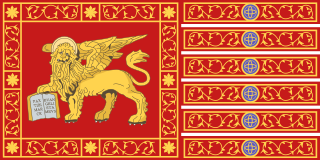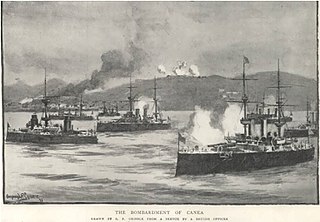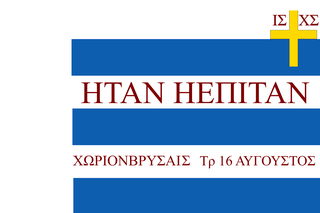
Crete is the largest and most populous of the Greek islands, the 88th largest island in the world and the fifth largest island in the Mediterranean Sea, after Sicily, Sardinia, Cyprus, and Corsica. Crete rests about 160 km (99 mi) south of the Greek mainland, and about 100 km (62 mi) southwest of Anatolia. Crete has an area of 8,450 km2 (3,260 sq mi) and a coastline of 1,046 km (650 mi). It bounds the southern border of the Aegean Sea, with the Sea of Crete to the north and the Libyan Sea to the south.

The history of Crete goes back to the 7th millennium BC, preceding the ancient Minoan civilization by more than four millennia. The palace-based Minoan civilization was the first civilization in Europe.
The Cretan Gendarmerie was a gendarmerie force created under the Cretan State, after the island of Crete gained autonomy from Ottoman rule in the late 19th century. It later played a major role in the coup that toppled the government of King Constantine in 1916, and also in the World War II Battle of Crete and the Greek Resistance that followed.

HMS Camperdown was an Admiral-class battleship of the Royal Navy, named after Adam Duncan, 1st Viscount Duncan of Camperdown.

The siege of Candia was a military conflict in which Ottoman forces besieged the Venetian-ruled capital city of the Kingdom of Candia. Lasting from 1648 to 1669, or a total of 21 years, it is the second-longest siege in history after the siege of Ceuta. It ended with an Ottoman victory, but the effort and cost of the siege contributed to the decline of the Ottoman Empire, especially after the Great Turkish War.
Greek Muslims, also known as Grecophone Muslims, are Muslims of Greek ethnic origin whose adoption of Islam dates to the period of Ottoman rule in the southern Balkans. They consist primarily of the descendants of the elite Ottoman Janissary corps and Ottoman-era converts to Islam from Greek Macedonia, Crete, and northeastern Anatolia and the Pontic Alps. They are currently found mainly in the west of Turkey and the northeast.

The Cretan Muslims or Cretan Turks were the Muslim inhabitants of the island of Crete. Their descendants settled principally in Turkey, the Dodecanese Islands under Italian administration, Syria, Lebanon, Palestine, Libya, and Egypt, as well as in the larger Turkish diaspora.

Mustafa Naili Pasha was an Ottoman statesman, who held the office of Grand Vizier twice during the reign of Abdülmecid I, the first time between 14 May 1853 and 29 May 1854, and the second time between 6 August 1857 and 22 October 1857.
The Pact of Halepa or Halepa Charter was an agreement made in 1878 between the Ottoman Empire and the representatives of the Cretan Revolutionary Committee, which secured wide-ranging autonomy for the island of Crete. It was named after the place where it was signed, Halepa.

The Cretan State was established in 1898, following the intervention by the Great Powers on the island of Crete. In 1897, the Cretan Revolt led the Ottoman Empire to declare war on Greece, which led the United Kingdom, France, Italy and Russia to intervene on the grounds that the Ottoman Empire could no longer maintain control. It was the prelude to the island's final annexation to the Kingdom of Greece, which occurred de facto in 1908 and de jure in 1913 after the First Balkan War.

The Cretan revolt of 1866–1869 or Great Cretan Revolution was a three-year uprising in Crete against Ottoman rule, the third and largest in a series of Cretan revolts between the end of the Greek War of Independence in 1830 and the establishment of the independent Cretan State in 1898.

The Theriso revolt was an insurrection that broke out in March 1905 against the government of Crete, then an autonomous state under Ottoman suzerainty. The revolt was led by the Cretan politician Eleftherios Venizelos, and is named after his mother's native village, Theriso, the focal point of the revolt.

The Realm or Kingdom of Candia or Duchy of Candia was the official name of Crete during the island's period as an overseas colony of the Republic of Venice, from the initial Venetian conquest in 1205–1212 to its fall to the Ottoman Empire during the Cretan War (1645–1669). The island was at the time and up to the early modern era commonly known as Candia after its capital, Candia or Chandax. In modern Greek historiography, the period is known as the Venetocracy.

The island of Crete was declared an Ottoman province (eyalet) in 1646, after the Ottomans managed to conquer the western part of the island as part of the Cretan War, but the Venetians maintained their hold on the capital Candia, until 1669, when Francesco Morosini surrendered the keys of the town. The offshore island fortresses of Souda, Grambousa, and Spinalonga would remain under Venetian rule until 1715, when they were also captured by the Ottomans.

Knossos, also romanized Cnossus, Gnossus, and Knossus, is the main Bronze Age archaeological site at Heraklion, a modern port city on the north central coast of Crete. The site was excavated and the palace complex found there partially restored under the direction of Arthur Evans in the earliest years of the 20th century. The palace complex is the largest Bronze Age archaeological site on Crete. It was undoubtedly the ceremonial and political centre of the Minoan civilization and culture.

The International Squadron was a naval squadron formed by a number of Great Powers in early 1897, just before the outbreak of the Greco-Turkish War of 1897, to intervene in a native Greek rebellion on Crete against rule by the Ottoman Empire. Warships from Austria-Hungary, France, the German Empire, Italy, the Russian Empire, and the United Kingdom made up the squadron, which operated in Cretan waters from February 1897 to December 1898.

The Lasithi massacres were a series of massacres committed against ethnic Turkish and Cretan Muslim civilians in 1897. They occurred in the Lasithi region of eastern Crete. Between 850 and around 1,000 people were murdered, including women and children.

The Cretan revolt of 1878 was an insurrection of the Cretan people against the Ottoman occupation of the island. This insurrection is part of a larger movement for independence from the Ottoman Empire, which Crete was part of since the middle of the 17th century.

The Candia massacre occurred on 6 September 1898, on Crete, then part of the Ottoman Empire. It occurred as a reaction by armed Muslim irregular groups (Bashi-bazouks) to the offer to the Christian community of a series of civil rights by foreign powers. They attacked the British security force in Candia, which was part of an international security force on the island.

The Cretan Revolt of 1897–1898 was a successful insurrection by the Greek population of Crete against the rule of the Ottoman Empire after decades of rising tensions. The Greek insurrectionists received supplies and armed support first from the Kingdom of Greece; then later from the Great Powers: the United Kingdom, France, Italy, Austria-Hungary, Germany and Russia. The conflict ended in 1898 with Cretan-allied victory and Ottoman retreat when the Great Powers cut their funding and proposed a resolution which stipulated:
- The Island of Crete become an autonomous state under the nominal sovereignty of the Ottoman Empire, with the Prince George of Greece as governor.
- The Ottoman Empire recognize the sovereignty of the Kingdom of Greece.
- The Kingdom of Greece recognize the sovereignty of the Ottoman Empire.

















